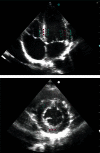Physiological basis in the assessment of myocardial mechanics using speckle-tracking echocardiography 2D. Part I
- PMID: 27446598
- PMCID: PMC4954859
- DOI: 10.15557/JoU.2016.0015
Physiological basis in the assessment of myocardial mechanics using speckle-tracking echocardiography 2D. Part I
Abstract
In this paper, the authors attempt to concisely present the anatomical and pathophysiological bases as well as the principles for echocardiographic evaluation of mechanical aspects of cardiac function based on speckle tracking method. This technique uses a phenomenon involving the formation of characteristic image units, referred to as speckles or acoustic markers, which are stable during cardiac cycle, on a two-dimensional echocardiographic picture. Changes in the position of these speckles throughout the cardiac cycle, which are monitored and analyzed semi-automatically by a computer system, reflect deformation of both, cardiac ventricle as a whole as well as its individual anatomical segments. The values of strain and the strain rate, as well as the range and velocity of the movement of these markers, which are in close relationship with multiple hemodynamic parameters, can be visualized as various types of charts - linear, two- and three-dimensional - as well as numerical values, enabling deeper insight into the mechanical and hemodynamic aspects of cardiac function in health and disease. The use of information obtained based on speckle tracking echocardiography allows to understand previously unclear mechanisms of physiological and pathophysiological processes. The first part of the study discusses the formation of a two-dimensional ultrasound image and the speckles, as well as the technical aspects of tracking their movement. The second part presents in more detail the methodology of speckle-tracking echocardiography, the characteristic abnormalities of cardiac mechanics presenting in different clinical entities, and the limitations related to given clinical and technical issues.
W niniejszej pracy autorzy podejmują próbę zwięzłego przedstawienia anatomicznych i patofizjologicznych podstaw oraz zasad echokardiograficznej oceny mechanicznych aspektów pracy serca w oparciu o metodę śledzenia markerów akustycznych. Metoda ta wykorzystuje zjawisko powstawania w dwuwymiarowym obrazie echokardiograficznym charakterystycznych, niezmieniających się w czasie jednostek obrazowych, określanych mianem plamek lub markerów akustycznych. Zmiany położenia plamek, obserwowane i analizowane półautomatycznie w trakcie całego cyklu serca przez system komputerowy, odzwierciedlają odkształcenie zarówno całej komory, jak i jej poszczególnych segmentów anatomicznych. Wartości odkształcenia, tempa odkształcenia oraz zakresu i prędkości ruchu markerów, pozostające w ścisłym związku z różnorodnymi parametrami hemodynamicznymi, mogą być prezentowane graficznie jako różnego rodzaju wykresy (liniowe, dwu- i trójwymiarowe) oraz wartości liczbowe, co umożliwia pogłębiony wgląd w mechaniczne i hemodynamiczne aspekty funkcji serca w stanach zdrowia i choroby. Wykorzystanie informacji płynących ze śledzenia markerów akustycznych umożliwia zrozumienie dotychczas niejasnych procesów fizjologicznych i patofizjologicznych. W pierwszej części pracy omówiono powstawanie ultrasonograficznego obrazu dwuwymiarowego i markerów akustycznych oraz techniczne aspekty analizy ich ruchu. W drugiej części przedstawiono bardziej szczegółowo metodykę badania za pomocą techniki śledzenia markerów akustycznych, omówiono charakterystyczne zaburzenia mechaniki mięśnia serca w różnych stanach klinicznych, a także wskazano ograniczenia metody spowodowane kwestiami technicznymi oraz problemami występującymi specyficznie w niektórych chorobach.
Keywords: myocardial strain; myocardial strain rate; speckle tracking echocardiography; ventricular function.
Figures








Similar articles
-
Physiological basis in the assessment of myocardial mechanics using speckle-tracking echocardiography 2D. Part II.J Ultrason. 2016 Sep;16(66):304-16. doi: 10.15557/JoU.2016.0031. Epub 2016 Sep 7. J Ultrason. 2016. PMID: 27679734 Free PMC article. Review.
-
Left ventricular myocardial strain by three-dimensional speckle-tracking echocardiography in healthy subjects: reference values and analysis of their physiologic and technical determinants.J Am Soc Echocardiogr. 2014 Aug;27(8):858-871.e1. doi: 10.1016/j.echo.2014.05.010. Epub 2014 Jun 26. J Am Soc Echocardiogr. 2014. PMID: 24975996
-
CT-derived left ventricular global strain: a head-to-head comparison with speckle tracking echocardiography.Int J Cardiovasc Imaging. 2019 Sep;35(9):1701-1707. doi: 10.1007/s10554-019-01596-8. Epub 2019 Apr 5. Int J Cardiovasc Imaging. 2019. PMID: 30953252
-
Evaluation of myocardial mechanics with three-dimensional speckle tracking echocardiography in heart transplant recipients: comparison with two-dimensional speckle tracking and relationship with clinical variables.Eur Heart J Cardiovasc Imaging. 2013 Dec;14(12):1167-73. doi: 10.1093/ehjci/jet065. Epub 2013 Apr 23. Eur Heart J Cardiovasc Imaging. 2013. PMID: 23612501
-
Speckle-tracking echocardiography: a new technique for assessing myocardial function.J Ultrasound Med. 2011 Jan;30(1):71-83. doi: 10.7863/jum.2011.30.1.71. J Ultrasound Med. 2011. PMID: 21193707 Review.
Cited by
-
Molecular Approaches and Echocardiographic Deformation Imaging in Detecting Myocardial Fibrosis.Int J Mol Sci. 2022 Sep 19;23(18):10944. doi: 10.3390/ijms231810944. Int J Mol Sci. 2022. PMID: 36142856 Free PMC article. Review.
-
Cardiac MR elastography for quantitative assessment of elevated myocardial stiffness in cardiac amyloidosis.J Magn Reson Imaging. 2017 Nov;46(5):1361-1367. doi: 10.1002/jmri.25678. Epub 2017 Feb 25. J Magn Reson Imaging. 2017. PMID: 28236336 Free PMC article.
-
Timing and magnitude of regional right ventricular function and their relationship with early hospital mortality in patients with acute pulmonary embolism.Anatol J Cardiol. 2019 Jun;22(1):26-32. doi: 10.14744/AnatolJCardiol.2019.38906. Anatol J Cardiol. 2019. PMID: 31264657 Free PMC article.
-
Prediction of subclinical left ventricular dysfunction by speckle-tracking echocardiography in patients with anti-neutrophil cytoplasmic antibody--associated vasculitis.Arch Rheumatol. 2021 Dec 24;37(1):129-135. doi: 10.46497/ArchRheumatol.2022.8916. eCollection 2022 Mar. Arch Rheumatol. 2021. PMID: 35949862 Free PMC article.
-
Myocardial tissue characterisation using echocardiographic deformation imaging.Cardiovasc Ultrasound. 2019 Nov 15;17(1):27. doi: 10.1186/s12947-019-0176-9. Cardiovasc Ultrasound. 2019. PMID: 31730467 Free PMC article. Review.
References
-
- Fogel MA. Ventricular Function and Blood Flow in Congenital Heart Disease. Blackwell Publishing Ltd; 2005. Ventricular Function – the Basics of the Discipline.
-
- Beręsewicz A, Mączewski M. Biofizyka serca. In: Beręsewicz A, editor. Patofizjologia niewydolności serca. Warszawa: CMKP; 2010.
-
- Buckberg GD, Hoffman JI, Coghlan HC, Nanda NC. Ventricular structure – function relations in health and disease. Part I: The normal heart. Eur J Cardiothorac Surg. 2015;47:587–601. - PubMed
-
- Lunkenheimer PP, Redmann K, Kling N, Jiang X, Rothaus K, Cryer CW, et al. Three-dimensional architecture of the left ventricular myocardium. Anat Rec A Discov Mol Cell Evol Biol. 2006;288:565–578. - PubMed
-
- Sengupta PP, Korinek J, Belohlavek M, Narula J, Vannan MA, Jahangir A, et al. Left ventricular structure and function: basic science for cardiac imaging. J Am Coll Cardiol. 2006;48:1988–2001. - PubMed
Publication types
LinkOut - more resources
Full Text Sources
Other Literature Sources
